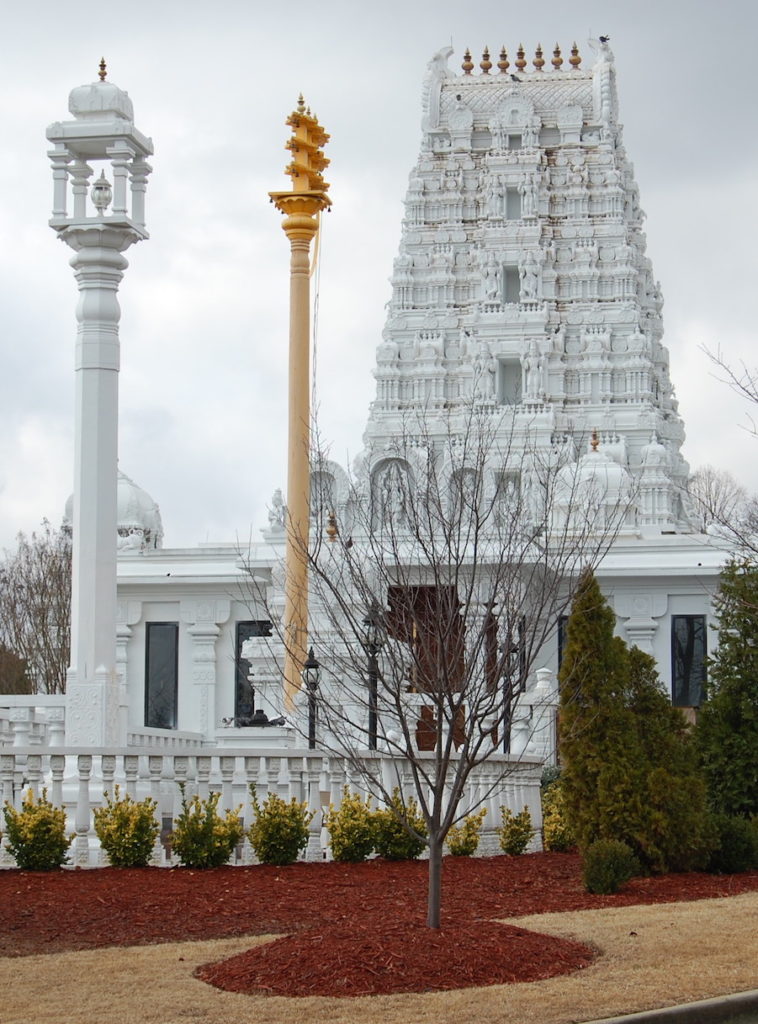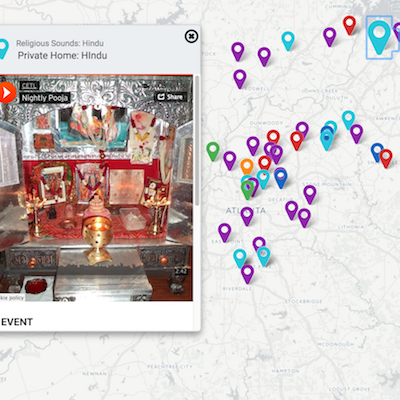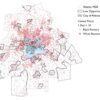What does faith sound like?
In Gwinnett County, religion sounds like bare feet accompanied by ankle bell-cuffs, pounding on an auditorium stage in traditional dance movements to enact sacred stories about Hindu deities. On Auburn Avenue, spirituality sounds like the rehearsal of a gospel choir punctuated by hand-held fans, swishing air across warm faces in the deep summer heat. In Woodruff Park, belief sounds like the voice of a dedicated street preacher, committed to saving the souls of folks heading toward Broad Street during their lunch break. And on 14th Street, faith sounds like the afternoon prayers at Al-Farooq Masjid, with bus horns honking faintly in the background.
As indicated to students who participate, the Religious Sounds Map Project layer in ATLMaps (embedded below) records and “documents the sounds associated with various religious communities, events, and individual practices in metropolitan Atlanta.”1 Individuals and communities in the metro area produce rich oral, musical, environmental, and manufactured sounds that reflect and generate their religious commitments. These sounds offer a unique insight into the ways in which religious individuals and groups live out their spirituality, particularly in unofficial and unexpected spaces, such as homes, public parks, auditoriums, and street corners.The Religious Sounds Map Project originated in the Department of Religious Studies at Georgia State University several years ago, and has expanded to include faculty at Ohio State University and Michigan State University. Currently led by Isaac Weiner (OSU) and Amy DeRogatis (MSU), the project involves student-based research supervised by faculty. At Georgia State University, I lead this effort, training students to identify and record religious sounds so that others can listen and learn from them. Over the years students in her Hinduism, Modern Judaism, Biblical Studies, and Religious Holidays courses have recorded sounds in public and private settings. We are now working to feature these recordings in an ATLMaps layer where visitors can locate specific sound “sites” (identified with colored pins) and listen to brief (45–150 seconds) religious sounds recordings. Many of these recordings are accompanied by thumbnail photos and brief explanations of the sounds contained in the archive.
The hope is that visitors to the site will come away with an enriched sense of the religious diversity of metropolitan Atlanta. Atlanta maintains its strong rootedness in the American South, but in recent years has also blossomed into a truly international city. In part this is due to the Immigration and Nationality Act of 1965, which abolished the quota system limiting the entry of immigrants into the United States. The 1965 act encouraged the immigration of foreign nationals with specific skills and prior connections with US residents or citizens. As a result, Atlanta-based universities and businesses began to attract students and skilled professionals from around the world, especially from Asia.

Initially these people came together in private homes and rented spaces to practice their religious and cultural traditions. But as time passed and the communities grew in number and wealth, permanent sites were often built, which housed not only worship but also broad cultural events, children’s education, and social services. And as the city prepared to host the 1996 Olympics, Atlanta began to tout its international community, and these religio-cultural communities received a public “boost.” Since that time, as Atlanta has continued to develop into a hub for national and international business, religious diversity has similarly continued to increase. Communities that were once small have grown (both in numbers and maturity) and established impressive buildings and programming. For example, the India American Cultural Society is the oldest Indian organization in the city, at one time serving as a kind of umbrella organization to a wide variety of Hindu communities that have since established their own buildings and community identities (e.g., Hindu Temple of Atlanta). At the same time, new, smaller immigrant communities continue to be established, often operating with very few resources. These religious communities often gather in private homes, rented retail spaces, and churches during off-peak times. Consequently, such immigrant religious communities and new religious movements are not immediately visible to Atlanta visitors or residents. However, the Religious Sounds Map layer allows users to acoustically encounter these communities’ festivals and religious services. Informal family gatherings are included alongside recordings of regular formal Methodist and Baptist worship. As a result, we are able to listen in on a wide range of religious activity, from formal to spontaneous, solemn to celebratory. In addition, the map captures the sounds not only of religious life activities that occur in firmly established communities and permanent structures but also of transient events that occur in living rooms, college auditoriums, and public parks, such as street preachers, seasonal festivals, and temporary regional gatherings. Ultimately, the sounds “pinned” on this map offer a collective religious profile of Atlanta, showcasing a wide range of religious expression that occurs (often simultaneously) across metropolitan Atlanta.The current map includes a “layering” feature that allows a user to call up different religious communities: Christian, Jewish, Hindu, etc. This allows the user to focus on specific communities of interest, which we hope will be helpful in multiple contexts, particularly K-12 classes where students are often being introduced to religious diversity as part of the US cultural landscape for the first time. The Religious Sounds Map will equip teachers to introduce students to communities they can’t visit and communities the teacher isn’t familiar with. In the future, the Religious Sounds Project hopes to include a layering feature that will generate versions of the map at different time periods in Atlanta’s history. The Religious Sounds Map of 1955 will look very different from the one of 1985, which will differ markedly from the map of 2015. Atlanta’s racial and ethnic diversity has increased over time, and population shifts (caused by immigration, urban “revitalization” efforts, and the influx of major corporations) have changed Atlanta’s religious identity.The site also offers an exciting teaching opportunity. Georgia State University students in my classes learn several skills over the course of completing the sound recording assignment. They learn the role of an Institutional Review Board (IRB) process and the importance of securing consent before recording and posting sound clips and personal interviews. They learn how to use digital technology to record the sounds and to create a 120–180 second clip to upload to the site. They learn how to act responsibly when seeking out sound events to record, keeping in mind issues of privacy, vulnerability, and power dynamics present in this kind of research. They see religious communities in geographic relationship with one another, which often reveals where distinct populations in our city are clustered.
The pins on the map effectively “level” the communities, directing the same attention, for example, to the activity of an informal gathering of Black Atheists that Ebenezer Baptist receives. Finally, the student researchers learn how time-consuming and messy it is to conduct research with fellow human beings.In the long run, I hope to bring my research together with Weiner and DeRogatis’s efforts to create a library of sound recordings from around Atlanta, Georgia, Columbus, Ohio, and East Lansing, Michigan. The American Religious Sounds Project hopes to develop a database of religious sounds that can be a rich resource for scholars, raising questions such as “What does religion in the United States sound like?” and “How might we understand religious diversity differently if we begin by listening for it?”2 In this comparative conversation, Atlanta’s religious diversity is distinctive. Atlanta’s religious diversity reflects our city’s evolution as a booming metropolis still grappling with its southern history while it strives to become a global economic, political, and cultural leader.
Citation: McClymond, Kathryn. “Listening for Religious Diversity: The Religious Sounds Map Project and ATLMaps.” Atlanta Studies. September 21, 2017. https://doi.org/10.18737/atls20170921.
- ATLMaps Religious Sounds. https://atlmaps.org/project/182/info. Accessed August 18, 2017.[↩]
- American Religious Sounds Project, Ohio State University, http://religioussounds.osu.edu/, accessed August 17, 2017.[↩]




